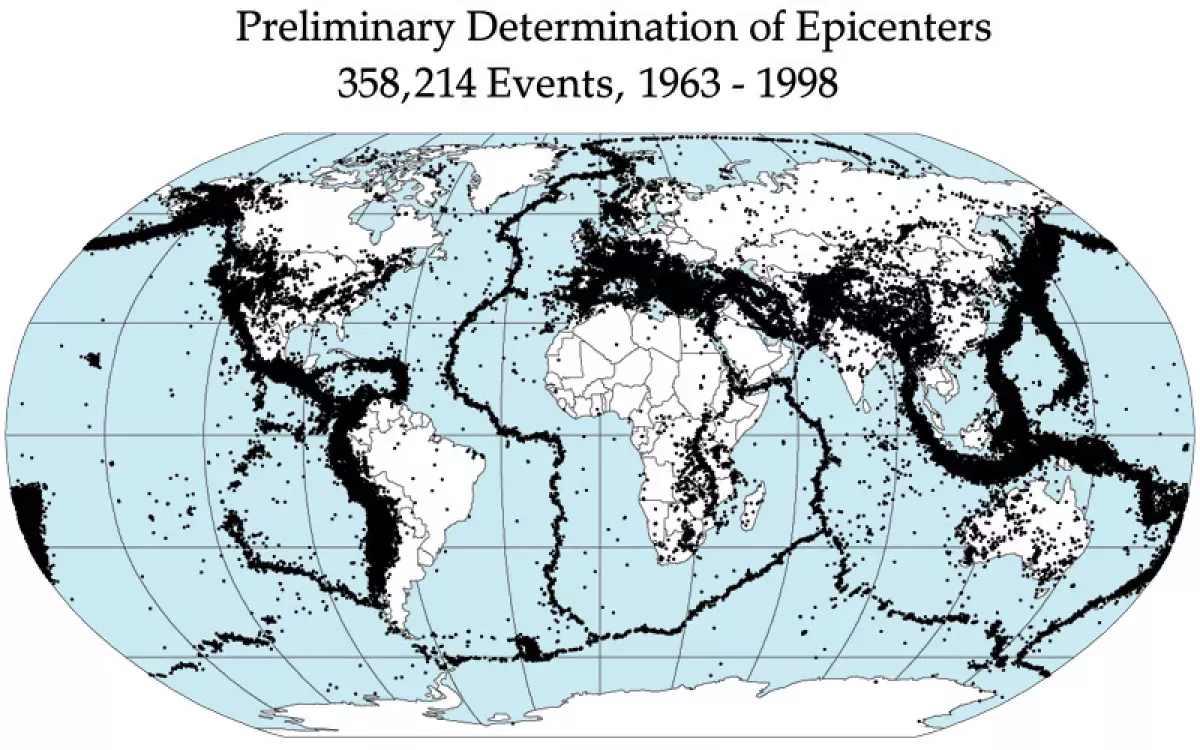An earthquake is the shaking of the Earth's surface caused by a sudden release of energy in the lithosphere, generating seismic waves. Their intensity varies greatly, from imperceptible tremors to catastrophic events capable of causing widespread destruction. Seismic activity refers to the frequency, type, and size of earthquakes in a region over time, while seismicity indicates the average rate of seismic energy release per unit volume at a specific location.
1900: Earthquake average estimation
Since 1900, the United States Geological Survey (USGS) estimates that there has been an average of 18 major earthquakes per year.
1906: San Andreas Fault Earthquake
In 1906, there was an earthquake along the San Andreas Fault.
1913: Earth's core was located by Beno Gutenberg
In 1913, the Earth's core was located by Beno Gutenberg using analysis of seismograms.
1931: Increase in Seismic Stations
In 1931, the number of seismic stations was about 350.
1935: Development of first earthquake magnitude scale
In 1935, Charles Francis Richter developed the first scale for measuring earthquake magnitudes.
1939: Earthquake in Turkey
In 1939, there was an earthquake along the North Anatolian Fault in Turkey.
1946: Vancouver Island earthquake
In 1946, the Vancouver Island earthquake affected Canada.
May 1960: Chilean earthquake measured on a seismograph
On May 22, 1960, the Chilean earthquake reached a magnitude of 9.5 on a seismograph. The epicenter was near Cañete, Chile.
1960: Earthquake in Chile
In 1960, an earthquake occurred in Chile in a subduction zone.
March 1964: Good Friday earthquake
On March 27, 1964, the Good Friday earthquake struck, which was centered in Prince William Sound, Alaska.
1964: Alaska earthquake
In the 1964 Alaska earthquake, soil liquefaction caused many buildings to sink into the ground, eventually collapsing upon themselves.
1968: The Ragged Edge
The Ragged Edge (1968) is a story about earthquakes.
1970: Ancash earthquake
Due to the 1970 Ancash earthquake, Peru had 22% of all landslide fatalities within the study.
1972: Short Walk to Daylight
Short Walk to Daylight (1972) is a story about earthquakes.
1976: Tangshan earthquake
The 1976 Tangshan earthquake was the deadliest earthquake of the 20th century, resulting in the deaths of 240,000 to 655,000 people.
1977: Goodbye California
Goodbye California (1977) is a novel depicting the "Big One" expected of California's San Andreas Fault someday.
1980: Eruption of Mount St. Helens
In 1980, the eruption of Mount St. Helens occurred, and earthquakes served as an early warning.
1988: Saguenay earthquake
In 1988, the Saguenay earthquake affected Canada.
1995: Kobe earthquake
The 1995 Kobe earthquake is an example of great cities laid to waste.
1996: Richter 10
Richter 10 (1996) is a novel depicting the "Big One" expected of California's San Andreas Fault someday.
1999: Aftershock: Earthquake in New York
Aftershock: Earthquake in New York (1999) is a story about earthquakes.
2001: Kunlun earthquake
In 2001, the Kunlun earthquake caused an unusually wide zone of damage that has been attributed to the effects of the sonic boom developed in such earthquakes.
2002: Denali Fault Earthquake in Alaska
In 2002, there was an earthquake along the Denali Fault in Alaska.
2004: Earthquake in Sumatra
In 2004, an earthquake occurred in Sumatra in a subduction zone.
2004: Earthquake swarm at Yellowstone National Park
In 2004, an earthquake swarm occurred at Yellowstone National Park.
2004: Indian Ocean earthquake
In 2004, the Indian Ocean earthquake occurred, and is one of the deadliest earthquakes in history.
2005: Kashmir earthquake
Due to the 2005 Kashmir earthquake, Pakistan had 21% of all landslide fatalities within the study.
2008: Sichuan earthquake
A Columbia University paper suggested that the 8.0 magnitude 2008 Sichuan earthquake was induced by loading from the Zipingpu Dam, though the link has not been conclusively proved.
2009: 2012
2012 (2009) is a movie depicting the "Big One" expected of California's San Andreas Fault someday.
2011: Tohoku-Oki earthquake
In 2011, gravitational records associated with the Tohoku-Oki (Fukushima) earthquake was analyzed.
August 2012: Earthquake swarm in Southern California's Imperial Valley
In August 2012, a swarm of earthquakes shook Southern California's Imperial Valley. It was the most recorded activity in the area since the 1970s.
2012: 2012
2012 (2009) is a movie depicting the "Big One" expected of California's San Andreas Fault someday.
2015: San Andreas
San Andreas (2015) is a movie depicting the "Big One" expected of California's San Andreas Fault someday.
2016: Scientists realized gravitational measurement could provide instantaneous detection of earthquakes
In 2016, scientists realized that gravitational measurement could provide instantaneous detection of earthquakes.
2021: Earthquake studies
A study group of 162 earthquakes (from 1772 to 2021) shows that China stood out in several categories, including landslide fatalities.
Mentioned in this timeline
California is a U S state on the Pacific Coast...

San Francisco is a major commercial financial and cultural hub...
China officially the People's Republic of China PRC is an...

Yellowstone National Park primarily in Wyoming with parts in Montana...
Japan is an East Asian island country situated in the...
Pakistan officially the Islamic Republic of Pakistan is a South...
Trending

22 minutes ago NY AG Seeks Disqualification of US Attorney Investigating Trump Lawsuits: A Legal Challenge
22 minutes ago Bologna Welcomes Back Immobile, Faces Parma with Recovered Ferguson, Aims to Rebound.

16 days ago Ja'Marr Chase Suspended One Game: Spitting Incident Sparks Controversy, Appeal Pending

6 months ago Joe Ryan's Fastball: A Valuable Pitch, Twins-Athletics Series Preview, Odds and Predictions

2 hours ago Jordan Spieth focuses on swing integrity, addresses backlash after career low.

2 hours ago Keegan Bradley Reflects on Ryder Cup Loss, Calls it Darkest Time
Popular
Aftyn Alyssa Behn is an American politician currently serving as...
Matt and Ross Duffer known as the Duffer Brothers are...

Lane Kiffin is an American football coach currently serving as...

XXXTentacion born Jahseh Dwayne Ricardo Onfroy was a controversial yet...

Stranger Things created by the Duffer Brothers is a popular...

William Franklin Graham III commonly known as Franklin Graham is...
